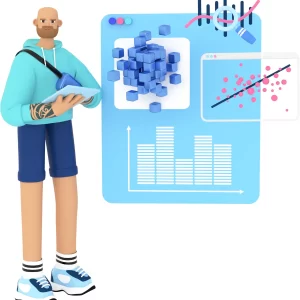For Business Enquiries – Click Here
Data Analyst vs. Data Scientist: Demystifying the Roles
The world is increasingly becoming data-driven, and the demand for professionals who can collect, analyze, and interpret data is growing rapidly. Two of the most in-demand data roles are data analyst and data scientist. While these roles are similar in some ways, they also have key differences.
In this blog post, we will explore the differences between data analysts and data scientists, including their education and work experience requirements, roles and responsibilities, skill sets, and job outlook. We will also provide tips on how to choose the right career path for you.
Data Analyst: Deciphering Data for Decisions
A data analyst’s primary role is to decode data, transforming it into actionable insights. These professionals utilize statistical analyses to uncover trends and provide valuable information to aid in decision-making. They often work with tools like SQL for database queries and employ programming languages such as R and SAS. Data analysts contribute to data-driven decision-making by creating reports, visualizations, and cleaning data for usability.

Data Scientist: Crafting Data Magic

Data scientists, on the other hand, take data analysis to the next level. They are involved in designing data modeling processes and creating algorithms and predictive models. Data scientists may spend more time on developing new tools and methods to extract complex information. This role demands not only mathematical and statistical expertise but also innovative problem-solving skills. They often use programming languages like Python, Java, and machine learning techniques.
Key Differences and Similarities
Both roles require at least a bachelor’s degree in quantitative fields like mathematics, computer science, or statistics. Data analysts typically focus on existing data, providing routine reports, while data scientists design data storage, manipulation, and analysis processes.
If you’re passionate about numbers, statistics, and programming, either path could be suitable. Analysts often answer specific business questions, while data scientists explore innovative ways of asking and answering vital questions.
Education and Experience
Both data analysts and data scientists typically need a bachelor’s degree in a quantitative field such as mathematics, statistics, or computer science. However, some data analysts may be able to get by with a bachelor’s degree in business with a focus in analytics.
Data scientists, on the other hand, are more likely to need a master’s degree or Ph.D. in a quantitative field. This is because data scientists often need to develop new tools and methods to extract the information that organizations need to solve complex problems.
In terms of work experience, data analysts may be able to get entry-level positions with little or no experience. However, data scientists typically need some work experience in a related field, such as data analysis or software engineering.
Roles and Responsibilities
Data analysts and data scientists both play important roles in helping organizations make better decisions. However, their specific roles and responsibilities differ.
Data analysts are typically responsible for collecting, cleaning, and analyzing data to identify trends and patterns. They may also create reports and dashboards to communicate their findings to stakeholders.
Data scientists, on the other hand, are typically more involved in developing new ways to collect, analyze, and interpret data. They may also be involved in building and training machine learning models to make predictions and solve complex problems.
Skills Comparison
Data analysts and data scientists both need a strong foundation in math and statistics. However, data scientists also need to have strong programming skills, as they often need to develop their own tools and methods.
Some of the common programming languages used by data scientists include Python, R, and Java. Data scientists may also need to have experience with big data tools such as Hadoop and Spark.
In addition to math, statistics, and programming, data analysts and data scientists also need to have strong communication and data visualization skills. They need to be able to communicate their findings to stakeholders in a clear and concise way.
Job Outlook
The job outlook for both data analysts and data scientists is very positive. The Bureau of Labor Statistics projects that employment of data scientists is expected to grow 28% from 2020 to 2030, much faster than the average for all occupations. Employment of business intelligence analysts, which includes data analysts, is projected to grow 11% from 2020 to 2030, faster than the average for all occupations.
Data Analyst vs Data Scientist
| Aspect | Data Analyst | Data Scientist</td> |
| Primary Role | Decode data and provide insights | Design data modeling, create algorithms, and predictive models |
| Data Analysis | Focuses on existing data | Explores innovative data collection and analysis methods |
| Tools Used | SQL, Excel, BI tools | Python, R, Java, machine learning |
| Educational Background | Bachelor’s degree in quantitative fields (e.g., mathematics, statistics) | Often holds advanced degrees (master’s or doctorate) |
| Work Experience | Often entry-level with varied experience | Varied, with some having 0-5 years of experience |
| Responsibilities | Explain why something happened, create dashboards, perform analytics | Predict future outcomes, design data models, develop big data infrastructures |
| Skills Emphasized | SQL, Excel, data visualization | Python, R, machine learning, data modeling |
| Job Outlook | Promising, with salaries often above national average | Promising, with high earning potential |
How to Choose the Right Career Path
If you are interested in a career in data, it is important to carefully consider your skills and interests when choosing between the data analyst and data scientist paths.
If you are interested in developing new tools and methods to collect, analyze, and interpret data, and you have strong programming skills, then the data scientist path may be a good fit for you.
If you are more interested in communicating data-driven insights to stakeholders, and you have strong communication and data visualization skills, then the data analyst path may be a good fit for you.

